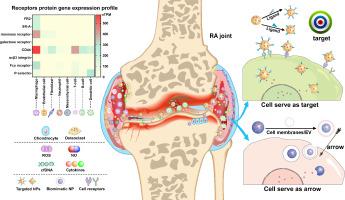当前位置:
X-MOL 学术
›
J. Control. Release
›
论文详情
Our official English website, www.x-mol.net, welcomes your feedback! (Note: you will need to create a separate account there.)
Nanomedicines targeting activated immune cells and effector cells for rheumatoid arthritis treatment
Journal of Controlled Release ( IF 10.5 ) Pub Date : 2024-06-12 , DOI: 10.1016/j.jconrel.2024.06.010 Yasi Deng 1 , Hao Zheng 1 , Bin Li 1 , Feibing Huang 1 , Yun Qiu 1 , Yupei Yang 1 , Wenbing Sheng 1 , Caiyun Peng 1 , Xing Tian 1 , Wei Wang 1 , Huanghe Yu 1
Journal of Controlled Release ( IF 10.5 ) Pub Date : 2024-06-12 , DOI: 10.1016/j.jconrel.2024.06.010 Yasi Deng 1 , Hao Zheng 1 , Bin Li 1 , Feibing Huang 1 , Yun Qiu 1 , Yupei Yang 1 , Wenbing Sheng 1 , Caiyun Peng 1 , Xing Tian 1 , Wei Wang 1 , Huanghe Yu 1
Affiliation

|
Rheumatoid arthritis (RA) is a chronic systemic autoimmune disease characterized by synovial inflammation and inflammatory cellular infiltration. Functional cells in the RA microenvironment (RAM) are composed of activated immune cells and effector cells. Activated immune cells, including macrophages, neutrophils, and T cells, can induce RA. Effector cells, including synoviocytes, osteoclasts, and chondrocytes, receiving inflammatory stimuli, exacerbate RA. These functional cells, often associated with the upregulation of surface-specific receptor proteins and significant homing effects, can secrete pro-inflammatory factors and interfere with each other, thereby jointly promoting the progression of RA. Recently, some nanomedicines have alleviated RA by targeting and modulating functional cells with ligand modifications, while other nanoparticles whose surfaces are camouflaged by membranes or extracellular vesicles (EVs) of these functional cells target and attack the lesion site for RA treatment. When ligand-modified nanomaterials target specific functional cells to treat RA, the functional cells are subjected to attack, much like the intended targets. When functional cell membranes or EVs are modified onto nanomaterials to deliver drugs for RA treatment, functional cells become the attackers, similar to arrows. This study summarized how diversified functional cells serve as targets or arrows by engineered nanoparticles to treat RA. Moreover, the key challenges in preparing nanomaterials and their stability, long-term efficacy, safety, and future clinical patient compliance have been discussed here.
中文翻译:

针对类风湿性关节炎治疗的激活免疫细胞和效应细胞的纳米药物
类风湿性关节炎(RA)是一种慢性全身性自身免疫性疾病,以滑膜炎症和炎性细胞浸润为特征。 RA 微环境 (RAM) 中的功能细胞由激活的免疫细胞和效应细胞组成。激活的免疫细胞,包括巨噬细胞、中性粒细胞和 T 细胞,可以诱发 RA。效应细胞,包括滑膜细胞、破骨细胞和软骨细胞,接受炎症刺激后会加剧 RA。这些功能细胞往往与表面特异性受体蛋白的上调和显着的归巢效应有关,可以分泌促炎因子并相互干扰,从而共同促进RA的进展。最近,一些纳米药物通过配体修饰靶向和调节功能细胞来缓解 RA,而其他纳米粒子的表面被这些功能细胞的膜或细胞外囊泡 (EV) 伪装,靶向并攻击病变部位以治疗 RA。当配体修饰的纳米材料靶向特定的功能细胞来治疗 RA 时,功能细胞会受到攻击,就像预期的目标一样。当功能性细胞膜或 EV 被修饰到纳米材料上以输送治疗 RA 的药物时,功能性细胞就成为攻击者,类似于箭头。这项研究总结了如何通过工程纳米颗粒将多样化的功能细胞作为靶标或箭头来治疗 RA。此外,本文还讨论了制备纳米材料及其稳定性、长期疗效、安全性和未来临床患者依从性的关键挑战。
更新日期:2024-06-12
中文翻译:

针对类风湿性关节炎治疗的激活免疫细胞和效应细胞的纳米药物
类风湿性关节炎(RA)是一种慢性全身性自身免疫性疾病,以滑膜炎症和炎性细胞浸润为特征。 RA 微环境 (RAM) 中的功能细胞由激活的免疫细胞和效应细胞组成。激活的免疫细胞,包括巨噬细胞、中性粒细胞和 T 细胞,可以诱发 RA。效应细胞,包括滑膜细胞、破骨细胞和软骨细胞,接受炎症刺激后会加剧 RA。这些功能细胞往往与表面特异性受体蛋白的上调和显着的归巢效应有关,可以分泌促炎因子并相互干扰,从而共同促进RA的进展。最近,一些纳米药物通过配体修饰靶向和调节功能细胞来缓解 RA,而其他纳米粒子的表面被这些功能细胞的膜或细胞外囊泡 (EV) 伪装,靶向并攻击病变部位以治疗 RA。当配体修饰的纳米材料靶向特定的功能细胞来治疗 RA 时,功能细胞会受到攻击,就像预期的目标一样。当功能性细胞膜或 EV 被修饰到纳米材料上以输送治疗 RA 的药物时,功能性细胞就成为攻击者,类似于箭头。这项研究总结了如何通过工程纳米颗粒将多样化的功能细胞作为靶标或箭头来治疗 RA。此外,本文还讨论了制备纳米材料及其稳定性、长期疗效、安全性和未来临床患者依从性的关键挑战。
















































 京公网安备 11010802027423号
京公网安备 11010802027423号